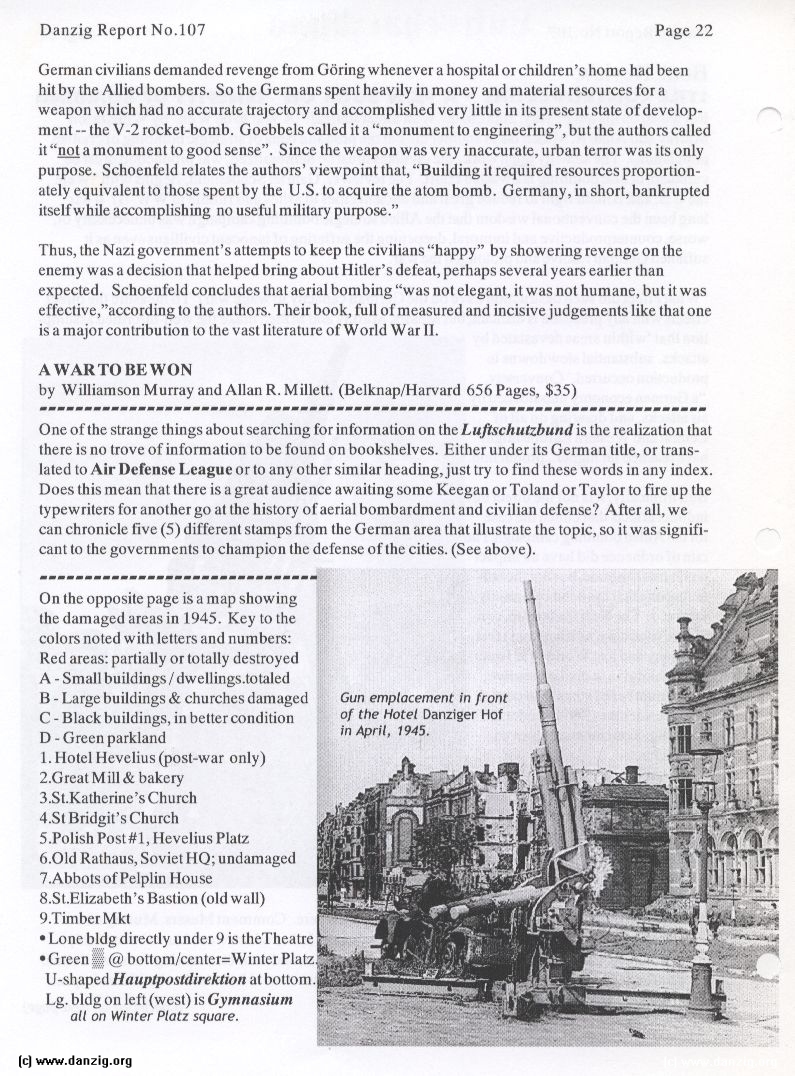
German civilians demanded revenge from Goring whenever a hospital or children’s home had been hit by the Allied bombers. So the Germans spent heavily in money and material resources for a weapon which had no accurate trajectory and accomplished very little in us present stale of developm ent --the V-2 rocket-bomb. Goebbels called it a “monument to engineering”, hut the authors called it “gj a monument to good sense”. Since the weapon was very inaccurate, urban terror was its only purpose. Schoenfeld relates the authors’ viewpoint that, “Building it required resources proportiona tely equivalent to those spent by the U.S. to acquire the atom bomb. Germany, in short, bankrupted itselfwhile accomplishing no useful military purpose.”
Thus, the Nazi government’s attempts to keep the civilians “happy” by showering revenge on the enemy was a decision that helped bring about Hitler’s defeat, perhaps several years earlier than expected. Schoenfeld concludes that aerial bombing “was not elegant, it was not humane, but it was effective,”according to the authors. Their book, full of measured and incisive judgeme nts like that one isa major contribution to the vast literature of World War 11.
A WAR TO BE WON
by Williamson Murray and Allan R. Millett. (Belknap/Harvard 656 Pages, $35)
One of the strange things about searching for information on the Luftschurbund is the realization that there is no trove of information to be found on bookshelves. Either under its German title, or transl ated to Air Defense league orto any other similar heading,just try to find these words in any index. Does this mean that there is a great audience awaiting some Keegan or Toland or Taylor to fire up the typewriters for another go at the history of aerial bombardment and civilian defense? After all, we can chronicle five (5) different stamps from the German area that illustrate the topic, so it was signific ant 10 the governments to champion the defense of the cities. (See above).
On the opposite page is a map showing the damaged areas in 1945. Key to the colors noted with letters and numbers: Red areas: partially or totally destroyed
A - Small buildings/dwellings.lotaled
B - Large buildings & churches damaged
C - Black buildings, in better condition
D - Green parkland
1. l-lotcl Hevclius (post-war only)
2.Great Miii & bakery
3St.Katherine’s Church
4.St Bridgit’s Church
5.Polish Post #1, Hevelius Plaiz
6.Old Rathaus, Soviet HO; undamaged
7.Abbots of Pelplin House
8.St.Elizabeth’s Bastion (old wall)
9.Timber Mkt
• Lone bldg directly under 9 is the Theatre
•Green! @ bottom/center=Winter Plats U-shaped HaupIstdirektion at bottom Lg. bldg on left (west) is Gymnasium all on Winter Platz square
Danzig Report Vol. 1 - Nr. 107 - April - May - June - 2000, Page 23.
Hits: 1546
Added: 28/07/2015
Copyright: 2024 Danzig.org

